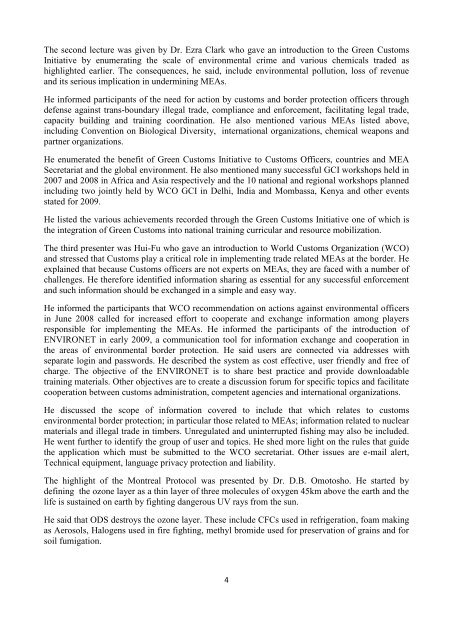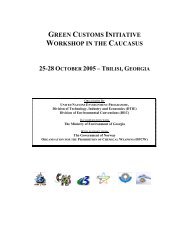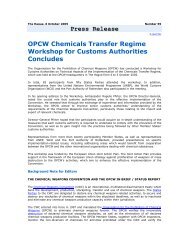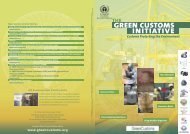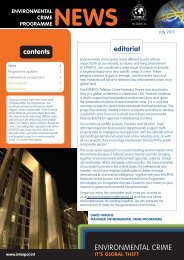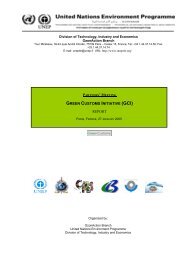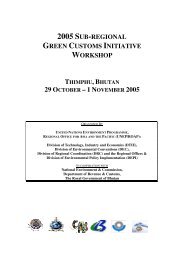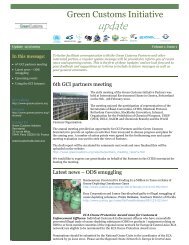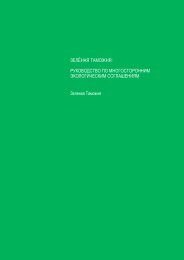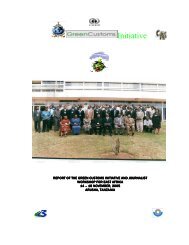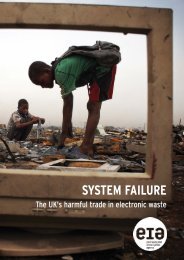workshop report. - Green Customs Initiative
workshop report. - Green Customs Initiative
workshop report. - Green Customs Initiative
You also want an ePaper? Increase the reach of your titles
YUMPU automatically turns print PDFs into web optimized ePapers that Google loves.
The second lecture was given by Dr. Ezra Clark who gave an introduction to the <strong>Green</strong> <strong>Customs</strong><strong>Initiative</strong> by enumerating the scale of environmental crime and various chemicals traded ashighlighted earlier. The consequences, he said, include environmental pollution, loss of revenueand its serious implication in undermining MEAs.He informed participants of the need for action by customs and border protection officers throughdefense against trans-boundary illegal trade, compliance and enforcement, facilitating legal trade,capacity building and training coordination. He also mentioned various MEAs listed above,including Convention on Biological Diversity, international organizations, chemical weapons andpartner organizations.He enumerated the benefit of <strong>Green</strong> <strong>Customs</strong> <strong>Initiative</strong> to <strong>Customs</strong> Officers, countries and MEASecretariat and the global environment. He also mentioned many successful GCI <strong>workshop</strong>s held in2007 and 2008 in Africa and Asia respectively and the 10 national and regional <strong>workshop</strong>s plannedincluding two jointly held by WCO GCI in Delhi, India and Mombassa, Kenya and other eventsstated for 2009.He listed the various achievements recorded through the <strong>Green</strong> <strong>Customs</strong> <strong>Initiative</strong> one of which isthe integration of <strong>Green</strong> <strong>Customs</strong> into national training curricular and resource mobilization.The third presenter was Hui-Fu who gave an introduction to World <strong>Customs</strong> Organization (WCO)and stressed that <strong>Customs</strong> play a critical role in implementing trade related MEAs at the border. Heexplained that because <strong>Customs</strong> officers are not experts on MEAs, they are faced with a number ofchallenges. He therefore identified information sharing as essential for any successful enforcementand such information should be exchanged in a simple and easy way.He informed the participants that WCO recommendation on actions against environmental officersin June 2008 called for increased effort to cooperate and exchange information among playersresponsible for implementing the MEAs. He informed the participants of the introduction ofENVIRONET in early 2009, a communication tool for information exchange and cooperation inthe areas of environmental border protection. He said users are connected via addresses withseparate login and passwords. He described the system as cost effective, user friendly and free ofcharge. The objective of the ENVIRONET is to share best practice and provide downloadabletraining materials. Other objectives are to create a discussion forum for specific topics and facilitatecooperation between customs administration, competent agencies and international organizations.He discussed the scope of information covered to include that which relates to customsenvironmental border protection; in particular those related to MEAs; information related to nuclearmaterials and illegal trade in timbers. Unregulated and uninterrupted fishing may also be included.He went further to identify the group of user and topics. He shed more light on the rules that guidethe application which must be submitted to the WCO secretariat. Other issues are e-mail alert,Technical equipment, language privacy protection and liability.The highlight of the Montreal Protocol was presented by Dr. D.B. Omotosho. He started bydefining the ozone layer as a thin layer of three molecules of oxygen 45km above the earth and thelife is sustained on earth by fighting dangerous UV rays from the sun.He said that ODS destroys the ozone layer. These include CFCs used in refrigeration, foam makingas Aerosols, Halogens used in fire fighting, methyl bromide used for preservation of grains and forsoil fumigation.4


